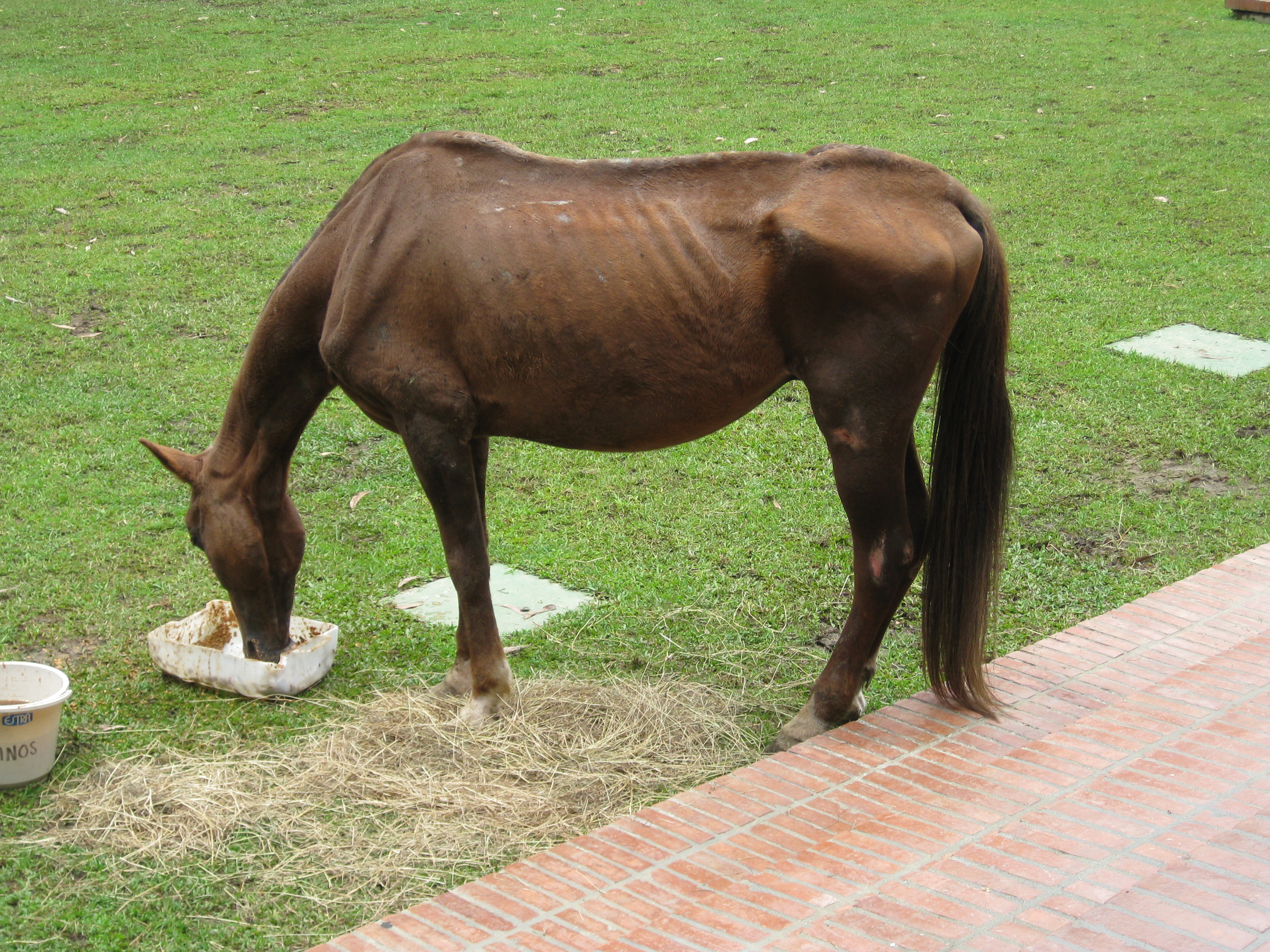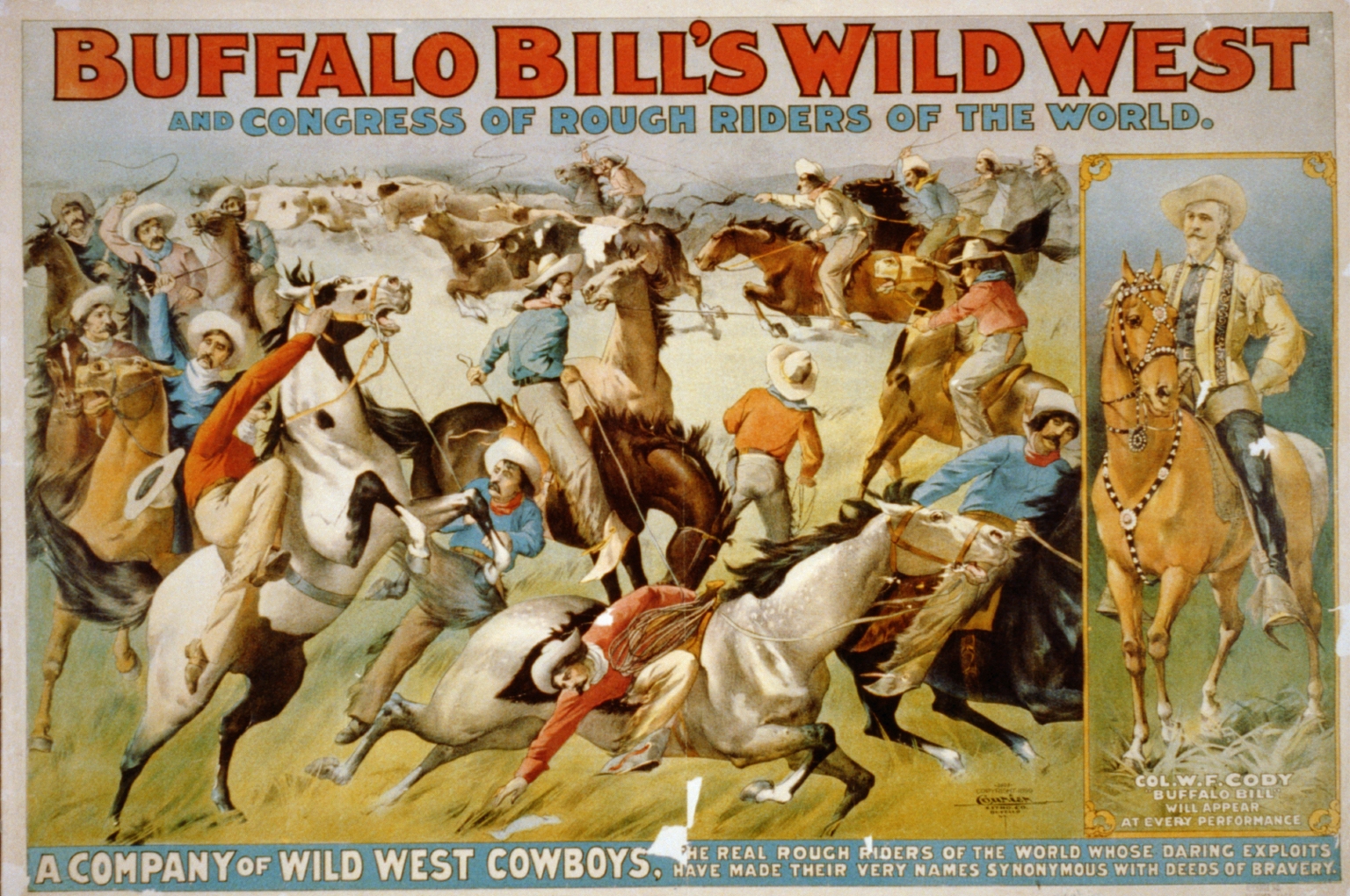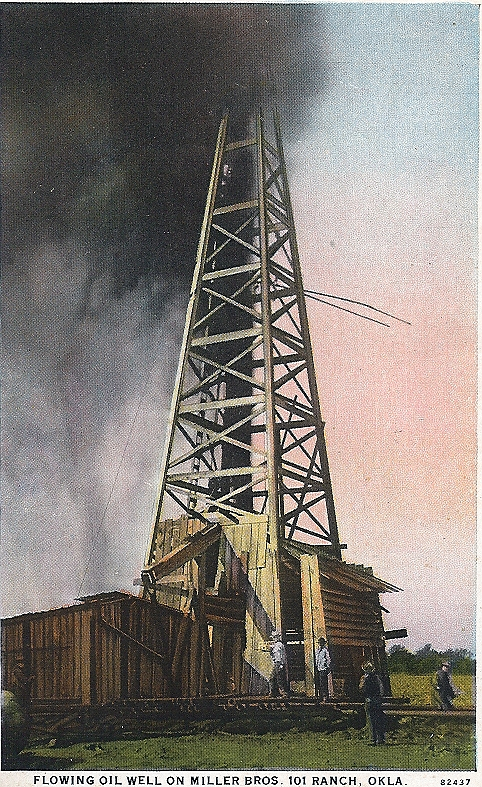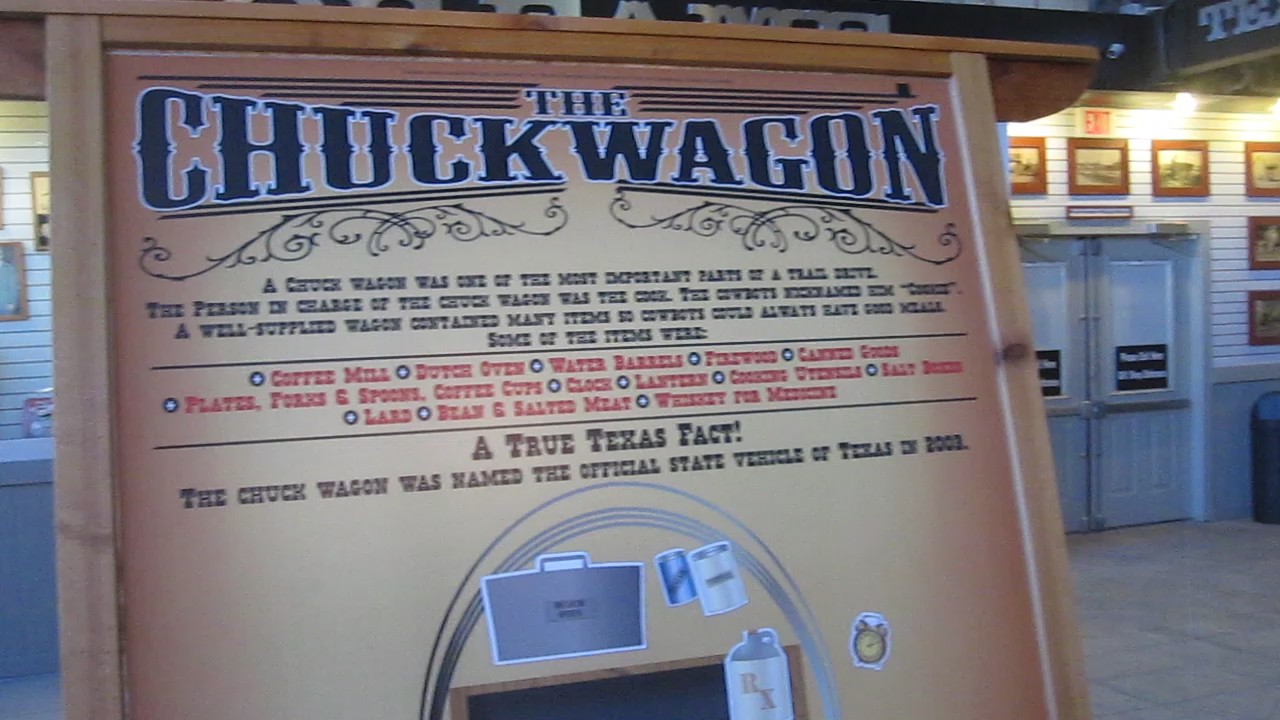|
Steer Wrestling
Steer wrestling, also known as bulldogging, is a rodeo event in which a horse-mounted rider chases a steer, drops from the horse to the steer, then wrestles the steer to the ground by grabbing its horns and pulling it off-balance so that it falls to the ground. The event carries a high risk of injury to the cowboy. Some concerns from the animal-rights community express that the competition may include practices that constitute cruelty to animals, but the injury rate to animals is less than 0.05%. A later PRCA survey of 60,971 animal performances at 198 rodeo performances and 73 sections of "slack" indicated 27 animals were injured, again around 0.05%. Origins Historically, steer wrestling was not a part of ranch life. The event originated in the 1890s, and is claimed to have been started by an individual named Bill Pickett, a wild-west show performer said to have caught a runaway steer by wrestling it to the ground. The several versions of the story have some claiming that he de ... [...More Info...] [...Related Items...] OR: [Wikipedia] [Google] [Baidu] |
Animal Cruelty
Cruelty to animals, also called animal abuse, animal neglect or animal cruelty, is the infliction by omission (neglect) or by commission by humans of suffering or harm upon non-human animals. More narrowly, it can be the causing of harm or suffering for specific achievements, such as killing animals for entertainment; cruelty to animals sometimes encompasses inflicting harm or suffering as an end in itself, referred to as zoosadism. Divergent approaches to laws concerning animal cruelty occur in different jurisdictions throughout the world. For example, some laws govern methods of killing animals for food, clothing, or other products, and other laws concern the keeping of animals for entertainment, education, research, or pets. There are several conceptual approaches to the issue of cruelty to animals. Even though some practices, like animal fighting, are widely acknowledged as cruel, not all people and nations have the same definition of what constitutes animal cruelty. Ma ... [...More Info...] [...Related Items...] OR: [Wikipedia] [Google] [Baidu] |
Bullfighting
Bullfighting is a physical contest that involves a bullfighter attempting to subdue, immobilize, or kill a bull, usually according to a set of rules, guidelines, or cultural expectations. There are several variations, including some forms which involve dancing around or leaping over a cow or bull or attempting to grasp an object tied to the animal's horns. The best-known form of bullfighting is Spanish-style bullfighting, practiced in Spain, Portugal, Southern France, Mexico, Colombia, Ecuador, Venezuela, and Peru. The Spanish Fighting Bull is bred for its aggression and physique, and is raised free-range with little human contact. The practice of bullfighting is controversial because of a range of concerns including animal welfare, funding, and religion. While some forms are considered a blood sport, in some countries, for example Spain, it is defined as an art form or cultural event, and local regulations define it as a cultural event or heritage. Bullfighting is ille ... [...More Info...] [...Related Items...] OR: [Wikipedia] [Google] [Baidu] |
Steer Wrestlers
Steer, Steers or Steering may refer to: Animals * Steer or bullock, castrated male cattle * Ox, a steer used as a draft animal People * Steer (surname) * Steers (surname) Places * Steer Creek (West Virginia), a tributary of the Little Kanawha River in central West Virginia in the United States * Steer Island, a former bar island in Summers County, West Virginia * Steer Stadium, a baseball park located in Graham, Texas Other uses * Steering, mechanism used to turn a vehicle * "Steer" (song), a 2007 song by Missy Higgins * Steers, South African fast food chain * STEER, a variant of PEST, a technique used in business analysis See also * Steers (other) Steers is one of South Africa's most recognizable quick-service restaurant brands. The company is well known for serving burgers and chips. Other menu items include chicken burgers, ribs as well as ice cream and milkshakes, among other things. ... * Steerage (other) {{disambiguation ... [...More Info...] [...Related Items...] OR: [Wikipedia] [Google] [Baidu] |
Wild West Show
Wild West shows were traveling vaudeville performances in the United States and Europe that existed around 1870–1920. The shows began as theatrical stage productions and evolved into open-air shows that depicted romanticized stereotypes of cowboys, Plains Indians, army scouts, outlaws, and wild animals that existed in the American West. While some of the storylines and characters were based on historical events, others were fictional or sensationalized. American Indians in particular were portrayed in a sensationalistic and exploitative manner. The shows introduced many western performers and personalities, and romanticized the American frontier, to a wide audience. History In the 19th century, following the American Civil War, stories and inexpensive dime novels depicting the American West and frontier life were becoming common. In 1869, author Ned Buntline wrote a novel about the buffalo hunter, U.S. Army scout, and guide William F. Buffalo Bill Cody called ''Buffalo ... [...More Info...] [...Related Items...] OR: [Wikipedia] [Google] [Baidu] |
Rodeo
Rodeo () is a competitive equestrian sport that arose out of the working practices of cattle herding in Spain and Mexico, expanding throughout the Americas and to other nations. It was originally based on the skills required of the working vaqueros and later, cowboys, in what today is the western United States, western Canada, and northern Mexico. Today, it is a sporting event that involves horses and other livestock, designed to test the skill and speed of the cowboys and cowgirls. American-style professional rodeos generally comprise the following events: tie-down roping, team roping, steer wrestling, saddle bronc riding, bareback bronc riding, bull riding and barrel racing. The events are divided into two basic categories: the Roughstock, rough stock events and the timed events. Depending on sanctioning organization and region, other events such as breakaway roping, goat tying, and pole bending may also be a part of some rodeos. The "world's first public cowboy contest" was h ... [...More Info...] [...Related Items...] OR: [Wikipedia] [Google] [Baidu] |
National Cowboy & Western Heritage Museum
The National Cowboy & Western Heritage Museum is a museum in Oklahoma City, Oklahoma, United States, with more than 28,000 Western and American Indian art works and artifacts. The facility also has the world's most extensive collection of American rodeo photographs, barbed wire, saddlery, and early rodeo trophies. Museum collections focus on preserving and interpreting the heritage of the American West. The museum becomes an art gallery during the annual Prix de West Invitational Art Exhibition and Sale each June. The Prix de West Artists sell original works of art as a fund raiser for the museum. The expansion and renovation was designed by Curtis W. Fentress, FAIA, RIBA of Fentress Architects. History The museum was established in 1955 as the Cowboy Hall of Fame and Museum, from an idea proposed by Chester A. Reynolds, to honor the cowboy and his era. Later that same year, the name was changed to the National Cowboy Hall of Fame and Museum. In 1960, the name was changed ... [...More Info...] [...Related Items...] OR: [Wikipedia] [Google] [Baidu] |
Chute Dogging
Chute dogging is a rodeo event related to steer wrestling, in which the steer used weighs between . However, the competitor starts the event in a roping chute with the steer as opposed to grabbing onto the steer from horseback. The event is designed to give novices a chance to prepare for steer wrestling. When the chute opens, the competitor must bring the steer to a line ten feet from the chute and wrestle (or "dog") the steer to the ground. In order to count as a legal fall, all four feet of the steer must be in the air when the steer is on the ground. Other falls are called "dog falls," and the competitor must try to let the steer get up and try to get all four legs in the air. The competitor can be disqualified for losing contact with the steer or tripping the steer. It is a timed event, with the time starting at the moment the chute dogger crosses the ten-foot line. The steer must be wrestled within 60 seconds. ReferencesSanctioned eventsat the International Gay Rodeo Associ ... [...More Info...] [...Related Items...] OR: [Wikipedia] [Google] [Baidu] |
101 Ranch Wild West Show
The Miller Brothers 101 Ranch was a cattle ranch in the Indian Territory of Oklahoma before statehood. Located near modern-day Ponca City, it was founded by Colonel George Washington Miller, a veteran of the Confederate Army, in 1893.Hoy, JimCattle Industry" Encyclopedia of Oklahoma History and Culture' (accessed March 5, 2015). The 101 Ranch was the birthplace of the 101 Ranch Wild West Show and one of the early focal points of the oil rush in northeastern Oklahoma. It was the largest diversified farm and ranch in America at the time. Bill Pickett's grave and the White Eagle Monument are located on the ranch grounds. The location of the former working cattle ranch was subdivided and all of its buildings destroyed. An area of the ranch is a National Historic Landmark. In 2003, the ranch was inducted into the Texas Trail of Fame. In 1903, when Colonel George Miller died, his three sons, Joseph, George Jr., and Zack took over operation of the 110,000 acre ranch. By 1932 most of ... [...More Info...] [...Related Items...] OR: [Wikipedia] [Google] [Baidu] |
ASPCA
The American Society for the Prevention of Cruelty to Animals (ASPCA) is a non-profit organization dedicated to preventing animal cruelty. Based in New York City since its inception in 1866, the organization's mission is "to provide effective means for the prevention of cruelty to animals throughout the United States." History Following the creation of the Royal Society for the Prevention of Cruelty to Animals (RSPCA) in the United Kingdom in 1824 (given Royal status in 1840), Henry Bergh founded the American Society for the Prevention of Cruelty to Animals on April 10, 1866, in New York City on the belief that "animals are entitled to kind and respectful treatment at the hands of humans, and must be protected under the law". It is the oldest animal welfare organization in the United States. On February 8, 1866, Bergh pleaded on behalf of animals at a meeting at Clinton Hall in New York City. Some of the issues he discussed were cockfighting and the horrors of slaughterhouses. A ... [...More Info...] [...Related Items...] OR: [Wikipedia] [Google] [Baidu] |
People For The Ethical Treatment Of Animals
People for the Ethical Treatment of Animals (PETA; , stylized as PeTA) is an American animal rights nonprofit organization based in Norfolk, Virginia, and led by Ingrid Newkirk, its international president. PETA reports that PETA entities have more than 9 million members globally. Founded in March 1980 by Newkirk and animal rights activist Alex Pacheco, the organization first caught the public's attention in the summer of 1981 during what became known as the Silver Spring monkeys case.Schwartz, Jeffrey M. and Begley, Sharon. ''The Mind and the Brain: Neuroplasticity and the Power of Mental Force'', Regan Books, 2002, p. 161ff. * Pacheco, Alex and Francione, AnnaThe Silver Spring Monkeys in Peter Singer (ed.) ''In Defense of Animals'', Basil Blackwell 1985, pp. 135–147. The organization opposes factory farming, fur farming, animal testing, and other activities the group considers as exploitation of animals. History Ingrid Newkirk Ingrid Newkirk was born in England in 1 ... [...More Info...] [...Related Items...] OR: [Wikipedia] [Google] [Baidu] |
Chuckwagon
A chuckwagon is a type of field kitchen covered wagon historically used for the storage and transportation of food and cooking equipment on the prairies of the United States and Canada. Such wagons formed part of a wagon train of settlers or fed traveling workers such as cowboys or loggers. In modern times, chuckwagons feature in certain cooking competitions and events. Chuckwagons are also used in a type of horse racing known as chuckwagon racing. History While some form of mobile kitchens had existed for generations, the invention of the chuckwagon is attributed to Charles Goodnight, a Texas rancher known as the "father of the Texas Panhandle," who introduced the concept in 1866.After the American Civil War, the beef market in Texas expanded. Some cattlemen herded cattle in parts of the country that did not have railroads, requiring them to be fed on the road for months at a time. Goodnight modified a Studebaker-manufactured covered wagon, a durable Civil War army-surplus w ... [...More Info...] [...Related Items...] OR: [Wikipedia] [Google] [Baidu] |


.jpg)



.jpg)
